Media | Articles
Beach Cars: The original, most adorable lifestyle vehicles
Beach cars have their root in the “economic miracle” that swept across postwar Italy, which provided a dramatic stimulus to the country’s automobile industry. This was especially true for the small coachbuilding firms headquartered in the north. Fueled by the manufacturers’ demands for specialized low-production models, styling assistance, and concept prototypes, display opportunities at major European auto shows quickly became a mecca for competitors and media to preview the latest trends and ideas.
Given its proximity to Italy’s major automakers, the annual Turin show often premiered the coachbuilders’ most advanced wares. It was there in 1956 that Pininfarina displayed an especially curious boatlike concept, featuring a cheery bulbous face, a cut-down panoramic windscreen, and a front bench seat that sat behind a topless, U-shaped teak seating area, completing the nautical theme. Based on Fiat’s 600 Multipla minivan and ordered by Fiat boss Gianni Agnelli, it was later used to ferry guests around at his 20-acre estate, Villa La Leopolda, on the French Riviera. A second example was acquired by Henry Ford II.
Jolly for the jet set
Though Pininfarina built only two such open-air vehicles, the concept of bespoke transport for the Riviera’s spectacular beaches and their affluent visitors was not lost on Pininfarina’s competitors. At the 1957 Turin show, Ghia presented its own interpretation, a charming alternative based on the Fiat 500 called the Jolly. “It was a very simple formula,” wrote Valerio Moretti in his extensive history of the firm. “Starting from a cheap, basic model, Ghia produced a skimpy body, little more than a floor assembly, without doors or roof, with wicker seats (plastic ones in the very basic models) of a nautical flavor.
The awning (with a Venetian-style fringe) and the chain instead of the doors was in the same style; the model was finished off with a carpet and shiny chromium pipes, producing a very attractive overall affect.” Ghia went on to produce multiple versions of the Jolly concept for Fiat as well for Renault’s 4CV. Several imitators later followed Ghia’s example in varying sizes and proportions, though the basic theme remained consistent: a simple top (or no top at all), cut-down doors, lightweight seats, and off-the-shelf mechanicals.

Swim suited
Though aimed at well-heeled European beachgoers (Grace Kelly and Aristotle Onassis owned them, too), the Jolly’s universal appeal wasn’t limited to the seashore. Car-loving U.S. president Lyndon Johnson drove one (apparently gifted from Fiat) with characteristic gusto around his Stonewall, Texas, ranch. It was joined there by an Amphicar, an appropriately named amphibious four-seater introduced in 1960, with the U.S. as its primary market.
Marketplace
Buy and sell classics with confidence
Powered by a Triumph-sourced 1.2-liter rear-mounted engine, its transition from car to boat took place through a lever that transferred engine power to two props below the rear bumper. On the ground and on the water, steering was handled by the front wheels, and when it came time to get back on dry land, engaging first gear gave the wheels enough propulsion to drive up a boat ramp.
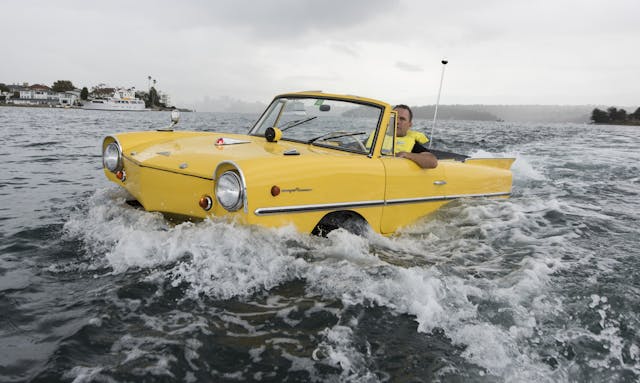
Sales of 25,000 Amphicars were ambitiously planned, but in the end only about 4000 were built. Despite being neither a particularly roadworthy car nor an especially seaworthy boat, the Amphicar has perpetual appeal (more so when on the water), though the vehicles have often been called to more serious duties, such as serving as adaptable rescue vehicles in flooded areas.
Littoral interpretations
The Amphicar failed to stimulate further serious iterations of dual-purpose coastal capabilities, but the concept of lightweight and affordable fair-weather transport was picked up by several other manufacturers outside Italy that saw them as low-investment brand extensions appealing to well-heeled jet-setters. British Motor Corporation’s front-wheel-drive Mini had enjoyed much the same success as its Fiat counterparts and was tailor-made for adaptation.
Alec Issigonis, the Mini’s effervescent creator, originally conceived of a lightweight, four-seat military transport that could be easily airdropped into war zones. When the prototypes failed to meet ground-clearance or performance targets, BMC instead commercialized the car in the early 1960s as the “Mini Moke” (Moke being slang for “donkey”). Built on a simple metal tub to which Mini components were attached at either end, Mokes were ultimately assembled in a variety of locations, where their simple construction didn’t require sophisticated production tooling. Approximately 50,000 were built.

Military aspirations also inspired Volkswagen to create its own counterpart to the Mini. Originally developed for the West German army, what VW formally named the Type 181 entered the U.S. consumer market as the “Thing,” and was sold around the world. Inspired in part by the VW-based World War II Kübelwagen, the Thing’s floorpans were adapted from the Type 1 Karmann Ghia due to its wider footprint; the Thing also featured a folding windshield and removable doors. VW even created a special “Acapulco” variant that directly riffed on its Jolly forebear, right down to its bright colors and striped fabric top. Civilian sales ended in 1980 after about 91,000 were built.
Beach-bound French citizens seeking a successor to Ghia’s original 4CV Jolly found an ideal successor in the Citröen Méhari, launched in 1968. As with the Moke, the Méhari’s mechanicals were adapted from a high-volume passenger-car base. Utilizing the 2CV’s classic air-cooled, two-cylinder engine, most Méharis were fitted with a durable and rust-free ABS plastic body. After 20 years of production, nearly 150,000 were built, including a few rare 4×4 models.
From sea to shining sea
Although the U.S. market didn’t share the benefit of low-cost, easily adaptable vehicles such as the BMC Mini or the Fiat 500, the coastal beach regions nonetheless spurred ideas for how best to access them. One early interpretation was the Willys Jeepster.
In the late 1940s, Willys Overland—based in Toledo, Ohio—was looking for ways to capitalize on the Jeep’s critical wartime role, as well as an existing pool of production tooling. The classic Jeep configuration was repurposed for civilian use as the “CJ” or Civilian Jeep, but Willys management also envisioned a companion carlike product. During the war, industrial-design legend Brooks Stevens argued presciently in Popular Mechanics that “today’s Jeep could become tomorrow’s popular car with minimum of fabrication of tooling and fabrication cost.”

That vision caught the attention of Willys engineering boss Barney Roos, who commissioned a series of postwar concepts from Stevens. One was called the “Jeepster,” a squared-off, colorful convertible with a folding top but no side windows. Perfectly capturing the aspirations of early postwar America, Jeepster brochures depicted handsome young buyers on the beach, at sporting events, or on a weekend adventure. With a launch price of $1765 at a time when a contemporary Ford or Chevy cost hundreds less, the four-cylinder Jeepster was also underpowered. Sales topped out at fewer than 20,000 units despite the late addition of a six-cylinder variant.
On the West Coast, sailboat builder Bruce Meyers would have considerably more success with his vision of a beach car, which began with a slightly modified VW Beetle chassis. Meyers then crafted a jaunty, minimalist fiberglass body to sit atop it—and the dune buggy was born. By combining the Beetle’s inexpensive mechanicals with Meyers’s cheap and sexy body, the Manx—named for a breed of tailless cat—was an immediate hit. Meyers created numerous variants, including the “Tow’d,” an off-road-only version designed to be towed to its destination, as well as the much more dramatically styled SR-2. Given the Manx’s high appeal and low-investment fiberglass construction, numerous companies got into the dune-buggy business, spawning several similarly styled competitors.
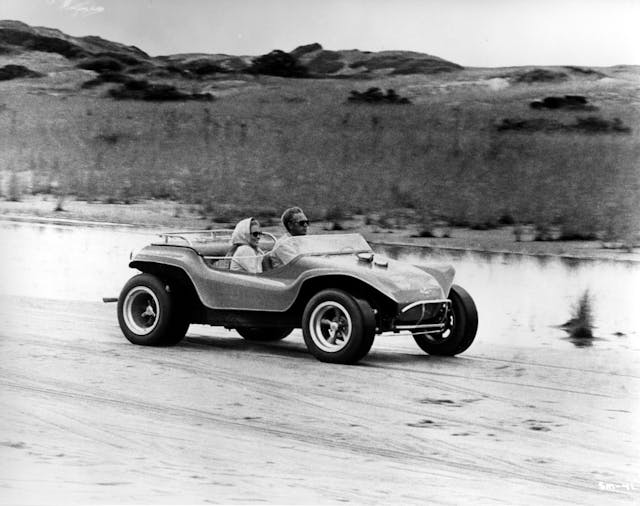
Not surprisingly, the lifestyle angle of beach cars often made them film and TV stars. The Mini Moke was featured in several films and television programs, the most popular of which was the quirky series The Prisoner, which starred Patrick McGoohan. Four Mokes with striped Surrey tops played a central role as transport around “The Village,” which was set in the Welsh town of Portmeirion. More dramatic was the Meyers Manx used in the original Thomas Crown Affair film, wherein art thief Steve McQueen attempts to impress insurance investigator Faye Dunaway in his highly customized Corvair-powered Manx as he rips across the dunes of Crane Beach on the north shore of Massachusetts.
What’s old is new again
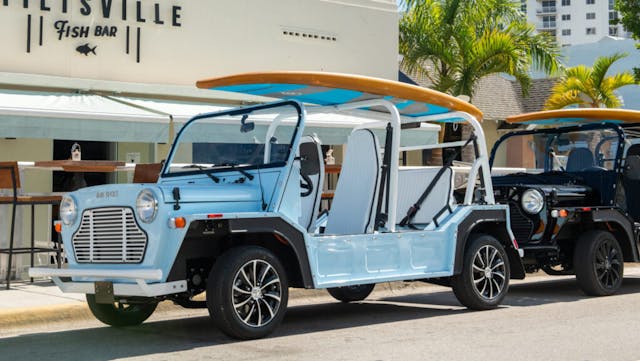
While the heyday of the most popular beach cars has long since faded, their appeal has not, inspiring multiple entrepreneurs to come up with ways of keeping them current. Moke America has reimagined the Moke as an EV with a range of 40 miles. The Manx has also been reborn as an EV, its classic lines brought up to date by designer Freeman Thomas. For those seeking a more traditional approach, Hampton Jollys will gladly make you a new Fiat 500–based Jolly, complete with a striped top and wicker seats, for about $85,000. For those preferring a more classic approach, original Jollys occasionally come up at auction, though usually at a substantially higher price. A 1959 example, reputed to be one of just 100 remaining examples, was sold in 2022 by RM Sotheby’s at Amelia Island for an impressive $146,000.
No one ever said life on the beach was cheap.
Beach Cars is one of 20 classes to be featured at the 2023 Greenwich Concours d’Elegance, on June 2-4, 2023. Download the 2023 Greenwich Concours d’Elegance event program to learn more about Sunday’s other featured classes, Saturday’s Concours de Sport, our judges, sponsors, non-profit partners, 2022 winners and more!
***
Check out the Hagerty Media homepage so you don’t miss a single story, or better yet, bookmark it. To get our best stories delivered right to your inbox, subscribe to our newsletters.
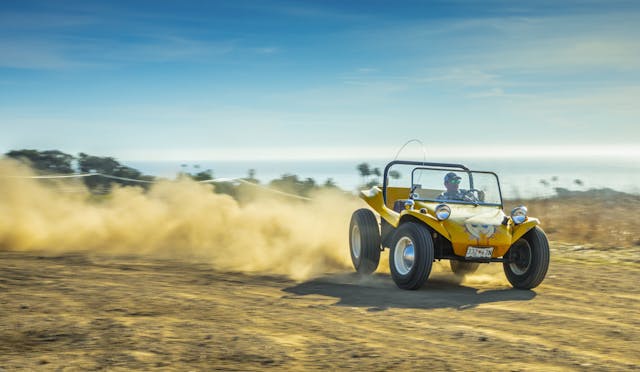








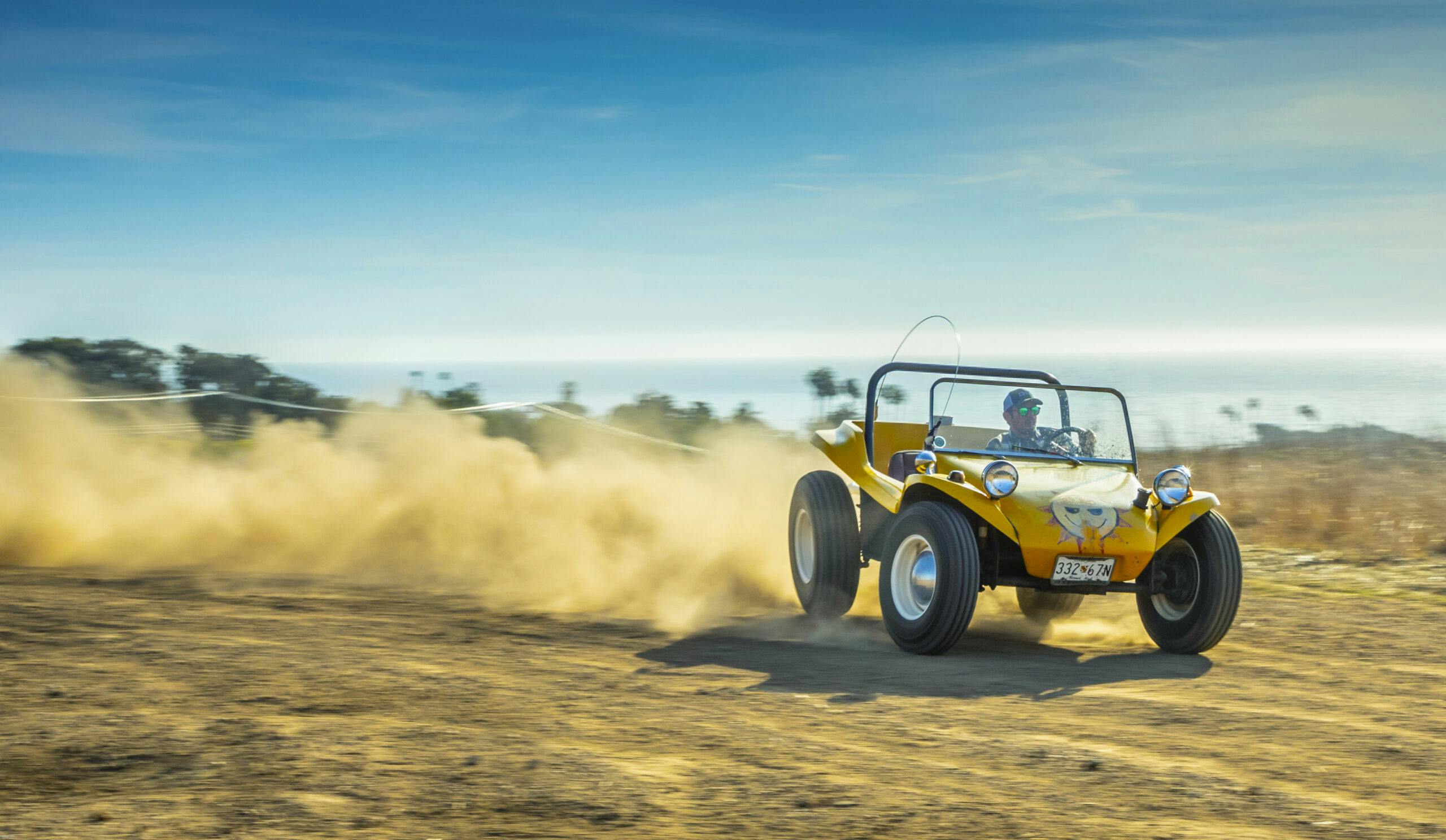
These cars are fun looking. If I lived on the beach I’d have one.
I don’t understand why Hagerty features these Dune buggies yet won’t provide insurance coverage here in Canada.